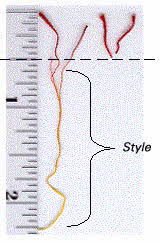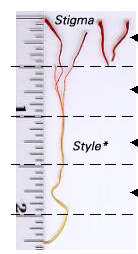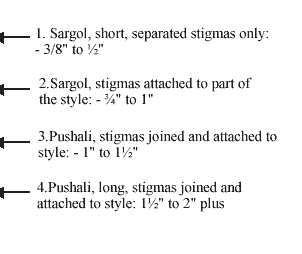Home | FOOD ARTICLES | Food Trivia | Today_in_Food_History | Food_History_Timeline | Recipes | Cooking_Tips | Food_Videos | Food_Quotes | Who’s_Who | Culinary_Schools_&_Tours | Food_Trivia_Quizzes | Food_Poems | Free_Magazines | Food_Festivals_and_Events
Food Articles, News & Features Section
FREE Magazines
and other Publications
Free Professional and Technical Research, White Papers, Case Studies, Magazines, and eBooks
SAFFRON (Crocus sativus)
Each saffron crocus flower has 3 stigmas, it takes about 80,000 flowers (240,000) stigmas to make a pound of saffron. It takes an experienced picker about 12 days to pick this many. By the time saffron gets to retail stores, its cost is $600 to over $2000 per pound.
I was given permission to use the following article on Saffron by Juan J. San Mames, President, Vanilla Saffron Imports www.saffron.com . They sell the highest quality saffron available. All copy and images ©Vanilla, Saffron Imports
Chef James.
Let's face it, you want both quality and value in saffron. As a saffron lover you appreciate the totally unique and seductive flavor, aroma and color saffron lends to a wide range of dishes. You don't want to pay an arm and a leg for saffron's uniqueness. But saffron is sold in the U.S. in many different grades from several different countries at many different prices. What's a consumer to do? Get educated! There are only three criteria you must look for every time you buy saffron:
 Saffron threads (Stigmas) are all red (no other color).
Saffron threads (Stigmas) are all red (no other color).
Saffron threads must be dry and brittle to the touch.
Saffron aroma is strong and fresh, never musty.
Keep these three criteria in mind every time you buy saffron. And do not be fooled into thinking that saffron's quality is tied to saffron's price. In other words, saffron's price is tied to how much saffron is harvested in a particular country and how many middlemen handle it before it reaches you.
There should be no other yellow or white plant parts (style) mixed in with the red threads (stigma), of the saffron crocus plant. This is the only part of the saffron crocus, which produces the saffron, the red stigmas. The way saffron-grading works is that the lower grades have more style left attached to the stigma.  As you examine the image on the left, you see that the stigmas are attached to a slender white style, which, when dried, turns pale yellow.
As you examine the image on the left, you see that the stigmas are attached to a slender white style, which, when dried, turns pale yellow.
The Style of the saffron plant, has NO CULINARY VALUE, that means NO AROMA, FLAVOR or COLOR. If is left attached to the red stigmas, it adds 30% to 50% DEAD weight to the saffron, and you pay for it. Note it’s as long as 1 ¾ inches. When dry, it curls and you can hardly see it.
The answer is simple. Iran's saffron production comprises more than 95% of the entire world production and we buy directly from the saffron co-operatives. Small saffron production and a long chain of middlemen between the farmer and you are the main reasons for saffron's high price.
If you calculate saffron's per recipe cost you will see how affordable it is. Our Sargol saffron is pure, potent and aromatic and flavors a recipe to feed six for just thirty cents. At $35.95 an ounce (28.35 grams), you are paying $1.27 per gram (24 servings) or five cents per serving. So with just one gram of Sargol saffron you can give aromatic flavor and gorgeous yellow color to either four recipes different recipes or one dish large enough for a big group. And you do not need to worry about buying an ounce of Sargol saffron because it has a shelf life of several years. All you have to do is keep it sealed in the beautiful tin can it’s pack in and away from light.
Finally, a note about the difference between Sargol saffron threads and powder. Both are excellent. Both are easy to use. It comes down to personal preference. For maximum flexibility, choose the threads. This way you can prepare dishes which show off the whole threads and you can easily crush the threads into powder for maximum color diffusion in dishes where this may be particularly important.
World Production: (Mt refers to Metric Tons)
Buying pure saffron has everything to do with BREAKING DOWN MYTHS. This is why I want you to know the latest figures on world saffron production: Iran 150/170 Mt., Greece 5/7 Mt., Morocco 2/3 Mt., Kashmir 2/3., Spain 1Mt. or less, Italy 100 kilos or less. No, Spain is NOT the biggest producer. Iran is the biggest producer in the world in terms of volume and quality. The truth is that the saffron "market" is in the hands of packers, not farmers. As a rule, packers buy all the saffron they are offered and then have to sell it quickly so that they can claim that it is from the most current crop year. So saffron comes into the market as a MIXTURE of different qualities from different countries. LOWEST price is the rule - QUALITY is of little concern to the packer. You can easily observe this when you open a sample of inferior saffron and notice the mixture of red, yellow and white material style left attached to the stigma or just yellow material added. You may also notice a musty smell and spongy texture due to excess moisture. You will only find stigma (threads) in our saffron.
What is coloring strength?
The general range of saffron coloring strength could be form 110-250+. Our saffron has a range of minimum of 230 to 255 degrees of color. The coloring strength should be clearly posted in the tin can according to ISO. Our SARGOL saffron does not contain any other part of the saffron plant except the pure red stigmas, which contain ALL of the spice's aroma, flavor and natural dye. Coloring power is the only measuring tool that assures you of CONSISTANT saffron quality. To get this number, saffron's principal chemical compound, CROCIN, is measured in a laboratory. The testing standards are written by the International Organization for Standardization (ISO). Saffron contains several chemical compounds. CROCIN is the one measured because it is a precursor to the other compounds, which together produce the three things your chefs are looking for: AROMA (safranal), FLAVOR (picrocrocin) AND COLOR (crocin). Pure, ALL RED saffron WILL MEASURE HIGHER on the coloring scale than saffron, which is mixed with other parts of the saffron plant.
What exactly is Sargol Saffron?
SARGOL SAFFRON is made up of the red stigmas which have been CUT and SEPARATED prior to drying. Stigmas cut this way provide MAXIMUM flavor, aroma and natural dye in cooking and baking. Improper harvesting and drying techniques seriously impact ultimate saffron quality. SARGOL SAFFRON is 100% pure saffron.
Grades of Iranian Saffron

When the stigmas remain attached to each other it is more difficult to achieve a low moisture content in the drying process. So even though the stigmas are slightly longer in (N-2 picture), their quality is not as high as when the stigmas are dried separately. In other words the "longer" the style the lower the quality of the saffron and the higher the "dead weight". Categories 3 Pushali and 4 Pushali are exported out of Iran to packers for further "MIXING" and repacking. These are the categories, which come into the USA as "Mancha" after they have been mixed with saffron from “other countries”. The bulk of this saffron in the mix is from Iran. To avoid confusing you, we only sell N-1, SARGOL SHORT. Sargol short is Saffron in it’s purest form.
Notice that usually two or three stigmas are join with the style. When left attached to the style, they capture inside up to 12% more moisture during the curing/drying process. This, plus the 1½" of style left attached, make up the 30% to 50% added weight. (Waste, we mentioned earlier). Again, we only sell the stigma.
Drying
This is the most important part of the saffron process. By cutting the stigmas apart prior to drying them, the "moisture" will evaporate out and no moisture remains inside the saffron stigma. When you leave the stigmas attached to each other, moisture is trapped inside the stigma. This shortens the shelf life and quality of the saffron. The drying process activates the chemical compounds, which release aroma, color and flavor. You can tell high moisture content in saffron by the soft or spongy texture to the touch. Moist saffron will develop a musty smell instead of saffron's distinct clean aroma. Our Sargol saffron's moisture is as low as 2% and its aroma is pleasantly memorable and distinct. Sargol *stigmas dried this way are brittle to the touch. You can crush them into powder between your fingers or with just a little pressure between two metal spoons.
Saffron Tea:
The secret to getting your money's worth with saffron is to buy *OUR Sargol saffron and then make a tea out of it before you add it to a recipe. Yes, a tea, sometimes referred to as an infusion or "steeping" saffron. This is exactly the same principle you use in making any tea - the longer the saffron steeps, the stronger its flavor, aroma and color. Where saffron preparation differs from tea is that you can release saffron effectively in hot liquid such as water, broth or milk or in room temperature white wine, vodka, rosewater, orange blossom water, white vinegar or citrus juice. In other words, saffron's chemicals respond positively to hot liquid or room temperature alcohol and acids (citrus).
The amount of liquid is not important, use whatever is called for in your recipe or add just a teaspoon or two of hot water to a recipe, which will not harm it. Then put the threads or powdered saffron in the liquid and leave it for a minimum of 20 minutes before you add this "tea" to the recipe. Do not remove the saffron threads from the liquid. They continue to release aroma, flavor and color for up to 24 hours which is why saffroned dishes and breads always taste even stronger as leftovers. With more flavor, aroma and color release than you would otherwise have, steeping saffron is the most economical way to use this spice.
Once you get comfortable cooking and baking with saffron, you will find the longer you steep your saffron, the less you will need per recipe. *Please note that we say *OUR Sargol. Which we consider different to all others, since ISO-3236 requires minimum 190 units of color for Category–1 saffron. Ours has 230/255 units of color, surpassing by 40 points ISO minimum requirements.
A special note about toasting OUR Sargol saffron: do not do it! It is unnecessary to dry OUR Sargol saffron any further because it has already been processed to exactly the right dryness for either steeping or crushing into powder. The only reason you might read elsewhere that saffron threads should be further dried prior to use is that lower grade saffron may contain too much moisture for good release of its aroma, color and flavor. Since Sargol saffron contains no excess moisture we do not want you to take a chance of spoiling it by scorching it over a flame, on top of the stove or in an oven.
I see you have no article on saffron so you may use "The Consumer Guide to Saffron Purchasing" I wrote for the student chefs at the Calfornia Culinary Academy SF, to clear up all their questions about saffron it only takes 10 minutes to read/study it and you will be an expert on the subject of saffron.
Thank you
Juan J. San Mames
President
Vanilla Saffron Imports 2-28-2003
All copy and images ®Vanilla, Saffron Imports
Vanilla Saffron Imports
949 Valencia Street
San Francisco. CA 94110
USA
415-648-8990
415-648-2240 fax
saffron@saffron.com
RELATED ARTICLES
Please feel free to link to any pages of FoodReference.com from your website.
For permission to use any of this content please E-mail: james@foodreference.com
All contents are copyright © 1990 - 2025 James T. Ehler and www.FoodReference.com unless otherwise noted. All rights reserved.
You may copy and use portions of this website for non-commercial, personal use only.
Any other use of these materials without prior written authorization is not very nice and violates the copyright.
Please take the time to request permission.

